|
Were you or anyone you know - father,
brother, son, uncle, nephew, grandfather, friend, enemy - attend the 1974
National Miniature Aircraft Championships (NATS) at Lake Charles, Louisiana? Why
that location was chosen for a mid-summer event is beyond me, but the NATS were
held there a few times. John Clemens was
Academy of Model Aeronautics (AMA)
president at the time. I had just become aware of the AMA a few years earlier at
the ripe old age of about 13. After 63 years on Earth I still have never
experienced a NATS - or the Toledo Show for that matter (which, alas, is no
more). I have managed to visit the AMA Headquarters in Muncie, Indiana, twice,
though, but that was nearly two decades ago shortly after they opened. ...but I
digress. Here is a thorough accounting of the goings-on at the 1974 AMA NATS as
presented in the November 1974 issue of American Aircraft Modeler magazine.
Behind the Scenes at the 'Most' Nats
 Before it started the 1974 National Miniature
Aircraft Championships had a lot going for it. It had the most competition events
ever - 65 - and the most space ever available to fly them in. It also had the most
unknowns. Would enough people come to make it all worthwhile? Would the weather
be too hot and humid? Would there be too many mosquitoes and other miserable creatures?
Would the stretched out schedule be workable? Before it started the 1974 National Miniature
Aircraft Championships had a lot going for it. It had the most competition events
ever - 65 - and the most space ever available to fly them in. It also had the most
unknowns. Would enough people come to make it all worthwhile? Would the weather
be too hot and humid? Would there be too many mosquitoes and other miserable creatures?
Would the stretched out schedule be workable?
People are what make the Nats the outstanding event it is. Not all can be shown,
but in these pages are some of the key people who deserve much credit.
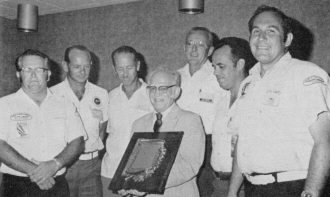
President John Clemens presenting AMA's Distinguished Service
Award to key officials of the LARKS Club.
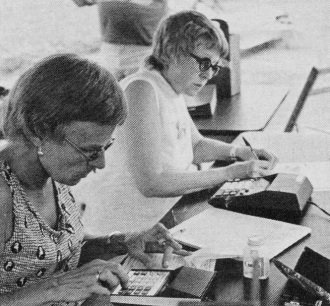
Pat Kendall (L) and Leeann Smith who handled RC Pattern tabulation
with calculators loaned by the Heath Company. (Thanks, Heath, and thanks to K &
B Manufacturing for supplying FAI and Quarter Midget fuel.)
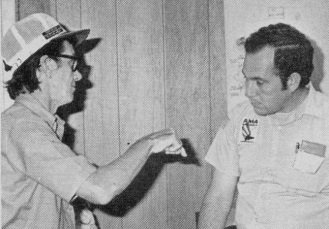
Larry Bolich (L), energetic PR Director for the City of Lake
Charles, and John Embry, the LARKS member who set in motion Lake Charles for the
Nats site.
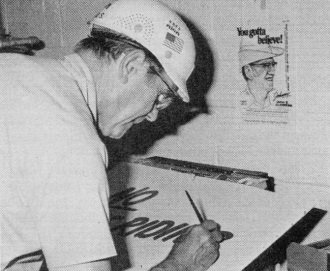
Les Hard rode herd on the daily Nats News and also hand-lettered
innumerable signs.
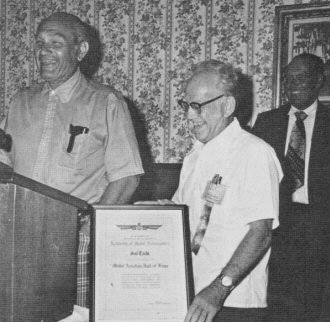
First of the 1974 Hall of Fame awards was presented to Sal Taibi
during the Nats Old-Timer Banquet. Shown (L-R): Taibi, President John Clemens, and
John Pond, banquet organizer.
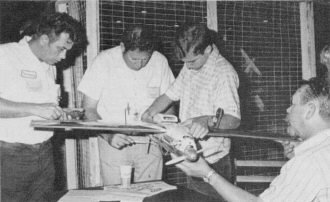
RC Pylon processing and judging crews (here shown checking FAI
specs) worked into the wee hours of the morning to handle the many entries.
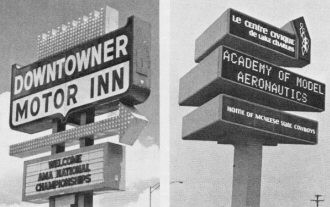
Signs shown are just two of many which welcomed the National
Contest and AMA member participants.
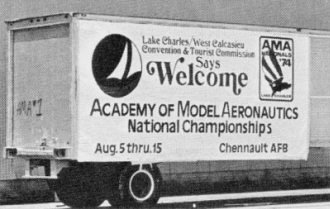
Sign on AMA trailer is similar to others displayed at the main
gateways to Lake Charles.
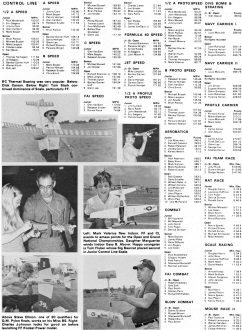
RC Thermal Soaring was very popular. Dick Carson. Tom Stark continued
dominance of Scale, particularly FF. Mark Valerius flew Indoor, FF and CL events
to amass points for the Open and Grand National Championships. Daughter Marguerite
winds Indoor Easy B. Happy youngster is Tom Fluker whose Sig Bearcat placed second
in Junior Control Line Scale. Steve Ellison, one of 20 qualifiers for Q.M. Pylon
finals, works on his Miss BS. Charles Johnson looks for good air before launching
FF Rocket Power model.
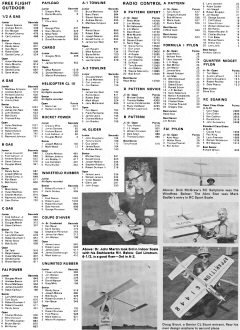
Dr. John Martin took 3rd in Indoor Scale with his Stahlwerke
RII. Carl Linstrum, 6-1/2, is a good flyer - 3rd in A-2. Dick McGraw's RC Sailplane
was the Windfree. The Akro Star was Mark Sadler's entry in RC Sport Scale. Doug
Stout, a Senior CL Stunt entrant, flew his own design airplane to second place.
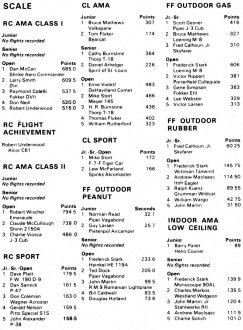
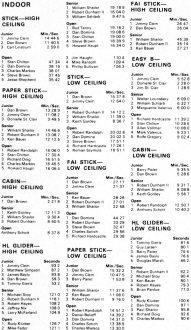
There were financial worries, too. It was expected that this would be a most
expensive Nationals in one particular area, travel costs for officials. Most of
the recent Nats were held in locations where many Nats officials didn't have to
travel very far. But this one would require long distance "importing" of many more
officials. Also, previous travel allowances had to be boosted in the current inflationary
period.
The big question behind such worries concerned the number of contestants to be
expected. In previous years when the Nats was held in Dallas - the nearest comparable
site - attendance was always the least of any Nats, mostly attributed to the typically
very hot Texas weather. Without enough contestants, the financial problems would
multiply because the fixed Nats costs would go on, and there might not be enough
attendees to help share them.
In addition to these concerns, there was a problem caused by the international
AerOlympics event held a month earlier in New Jersey. The AerOlympics required some
key people who would not be available to help with the Nationals, since they couldn't
make both events. And even among those who could help in both, some might be so
worn out from the AerOlympics, that they would be ineffective for the Nats.
To sum up, this Nats had many worries for those responsible for organizing and
operating the event. In addition, they felt an obligation to improve on the 1973
Nats which had been an unhappy experience for many participants. The 1973 problems
could be written off due to the fact that they were natural for such a major event
being run for the first time without outside help or sponsorship. But for 1974 similar
thinking would not be accepted. AMA was expected to do better.
The 1974 Nats was better, far better than most had hoped for. For many it apparently
was the, best Nats ever - a lot of them stopped by Nats HQ on the way to say so.
Free Flighters in particular, even though they had some retrieving problems, were
a much happier group than they had been at Oshkosh the year before. Control Liners
and Radio Controllers also were generally happy. RC Formula I and FAI Pylon Racing
people praised their site as the best yet.
It wasn't all rosy, but it obviously was pretty good for most people. It was
the easiest Nats ever for getting around. There were so few restricted areas that
most people could simply drive wherever they wanted to go at any time. There weren't
any restricted hours of operation either. Although contestant and official bumper
stickers for cars were issued, to distinguish them from general public vehicles,
they weren't really necessary. Control Line and Free Flight test and fun flying
went on constantly - flyers could simply find their own part of the field to fly
on, without anyone telling them they couldn't do this or that. Free Flight retrieval
had the greatest freedom ever at a Nats for cars or motor bikes. Obviously, there
was lots of room - so much so that RC officials had problems deciding where to fly
from!
One of the disappointments was the lack of help for many events. Only about half
of those who had previously volunteered to work at the Nats actually showed. This
made it harder for those who did come. The new events especially felt the pinch.
RC Quarter Midget and also Thermal Soaring managed, but just barely. However, although
these were brand new to the Nats, they ended up successfully. The other RC events
did better with manpower, but CL events also shared the lack of personnel. In general,
it was a case of too few doing too much, but the job did get done and happily for
most contestants.
The weather turned out to be different from what most people expected. Sometimes
it got as hot and humid as had been feared. But there was nowhere near as much of
this as had been anticipated. The first week of the Nats, in fact, was comparatively
mild. There were some whopping rain storms, but none of these lasted long enough
to seriously hurt the flying schedule. Evening hours were also available when schedules
had to be stretched to make up for weather interruptions. Free Flight Scale, however,
had its usual luck of too much wind. It doesn't seem to matter when and where FF
Scale is scheduled; wind has plagued this event for several years in a row.
Most amazing was the localization of the rain. It often showered on one part
of the field without bothering other parts: During the Sunday afternoon air show,
for example, it rained only on the show - two hundred yards away Control Line Stunt
finalists continued uninterrupted, and about a mile and a half away (still on the
same airfield!) RC Scale didn't get any rain at all. Likewise, on the final day,
RC Pattern didn't get any rain while the HQ hangar area was drenched. The net effect
of the rain pattern was the development of a general attitude of ignoring the rain
or simply waiting for it to go away.
Indoor events went on for four straight days (and nights) from 9 am to 9 pm,
but split between two widely separated sites: high ceiling at Spring, Texas (near
Houston), and low ceiling at Lake Charles. Both sites were enjoyed, but the consensus
seemed to be that only one site was necessary and there was lots of pro and con
regarding both.
The Goodyear hangar in Texas was a good first-time Nats Indoor site as was the
Civic Center in Lake Charles. Apparently, however, the Goodyear site was not enough
higher to justify the extra travel distance, especially since the smooth but lower-ceilinged
Civic Center made the latter equivalent to a higher building. Regardless, there
was more Indoor flying scheduled than ever before, so there were not many complaints.
Talk of snakes prevailed, but there were few to be found and no cases of snake
bite were reported. The real problem turned out to be red ants. Many people got
ant bites, and a few required shots of penicillin at the local hospital when severe
swelling developed. But that was the most serious problem. The most pleasant surprise
was the lack of mosquitoes in what should be prime breeding country for these pests.
The evenings were particularly bug free - even the concentration of lights in the
headquarters hangar area didn't cause any bug problems. Evenings were generally
pleasant.
Enough contestants came to wipe out the worries about numbers - over a thousand,
plus hundreds of mechanics, family members, and helpers. They filled all the area
motels and all the available college dormitory space in five separate buildings.
The only lack of people involved campers - there were some but not as many as had
been expected.
Because activities were spread out so much over the huge airfield, the usual
crowded Nats atmosphere was missing. It wasn't really a lack of people - they were
simply scattered. Combat for example, was located far away from the other Control
Line events in order to use a better grass area. The RC, CL, and FF areas were actually
completely out of sight of each other during much of the Nats.
The college dorms were especially great. The air-conditioning was actually overdone,
and the use of blankets was common until thermostats got adjusted to provide less
cooling! The college cafeteria was not available for meals, but there were enough
other good and reasonably priced eating places to minimize the food problem. Also
helping the eating situation was a large variety of food concessions in the airfield
hangar. Besides the usual hot dogs, hamburgers, and soft drinks, there was pizza,
soft ice cream, watermelon, roast beef, iced tea, coffee, and other pleasantly unique
food items for a Nats.
Contributing to the generally happy mood that prevailed during the Nats was the
genuinely hospitable community spirit. It was constantly plain that Nats contestants
and officials were welcome everywhere. Those staying in motels often commented on
the friendly atmosphere toward AMA people. Similarly, those in the dorms frequently
praised the cooperation and helpfulness of college personnel.
The climax of this spirit came during a special session of the Lake Charles City
Council when the AMA president and the executive director were presented keys to
the city and were made honorary citizens. Other gifts were presented during the
Sunday air show, including a pair of the governor's cuff links given to the AMA
president. No doubt about it - Lake Charles people were happy to have us there.
They even had billboards at the east and west entrances to the city welcoming AMA
and the Nats to Lake Charles.
But maybe there's too much of a good thing. Well into the second week of the
Nats some of the officials were really dragging. For some who had been on hand since
a week before the Nats began, it was a very long operation. However, this didn't
seem to be the basic problem with the long Nats. Rather it was the lonely ending
caused by the nature of the schedule.
Free Flight ended after only five days, and so did Control Line except for Slow
Combat which provided a sixth day. But RC, including the unofficial Helicopter event,
went on for twelve straight days! Included for the first time was Quarter Midget
Pylon Racing and two classes of Thermal Soaring. But making room for these required
Pattern to go into the second week. Originally, AMA RC Scale was supposed to share
part of the second week with RC Pattern, but when only a few AMA Scale entries appeared
it was decided to run them off on the same day (Sunday) as RC Sport Scale. This
left Pattern all alone for the last four days to finish up the Nats, and there were
gripes about Pattern being isolated and ignored.
Contributing to the feeling was the field clean-up going on while Pattern was
all alone during the second week; most of the headquarters' staff had gone back
to Washington, and most concessions were closed down. Some RC'ers even mentioned
missing seeing CL and FF flying; in contrast to other years when most of them ignored
any other event besides their own.
As a result of this lonely second week, some new thinking is currently going
on concerning next year's schedule. Most likely is a slow start-up with simultaneous
finish for all events rather than this year's tapering off. Chalk up the experience
to an experiment that solved some problems but created others.
The 1974 schedule also made it awkward to find a natural time for the usual Nats
RC banquet. Pylon ended on Saturday, but Pattern didn't start until the following
Monday. There was also transmitter processing for Pattern and Scale on Saturday
and Sunday nights. So the RC banquet gave way to a general Nats banquet on Saturday
night. It was fairly successful and indicated that such a banquet would be a good
thing for future Nats, but a better schedule has to be worked out to prevent the
lack of RC participation.
A spectacular sight on the first Tuesday night was the processing hangar. In
addition to the usual Free Flight and Control Line model processing, there were
115 RC Pylon models being measured and judged! The hangar was absolutely jammed
with people and models. It all went very smoothly, but it was a long night - the
RC processing went on until one am Wednesday morning. It was another problem with
the new schedule that caused the crowding - not desirable, but it added some special
flavor to the Nats (the one time that everybody seemed to be at the same place at
the same time) and most everyone stayed cheerful through the long night.
Throughout the Nats a special group of people kept things under control and earned
tremendous praise and respect. These were the people who were behind the bid to
have the Nats at Lake Charles, and they followed up by providing a fantastic amount
of backup support before, during, and after the 1974 Nats. Approximately twenty
members (and wives) of the Lake Area Radio Kontrol Society (L.A.R.K.S.) worked constantly
to keep many details of the Nats operating. They painted all the circles on the
airfield, emptied trash barrels, provided water and ice to events, acted as timers,
flagmen, and other officials, transported equipment all over the field, posted signs,
put up tents, mowed grass, loaded and unloaded trucks and trailers, repaired and
assembled Nats gear, installed air-conditioners in the headquarters offices, made
electrical hookups for events and concessions, swept floors, installed over two
miles of field telephone wire, roped off and barricaded thousands of feet of the
airfield, erected the Scale and trophy cages and shelving (then disassembled same),
unpacked over 800 trophies, and much more.
Blue-shirted LARKS were everywhere all the time. Some took two and three week
vacations from their jobs and used all of it for Nats work. They were on hand by
eight each morning and typically worked until eight each night. The effort was so
outstanding that AMA's Executive Council voted the LARKS the AMA Distinguished Service
Award. Nats Executive Committee members also noted that the LARKS provided the greatest
local area Nats support effort ever seen - an incredible and marvelous example of
how an AMA chartered club can contribute to an event such as the Nats.
The LARKS effort is a strong factor favoring a return of the Nats to Lake Charles
for 1975. This, plus the excellent (and huge) Chennault Airfield, the great hotel
and dormitory facilities, the very favorable community backing, makes the Lake Charles
package a difficult combination to beat. Backers note that 1975 conditions will
be even better - many wooded and heavily shrubbed areas of the airfield will be
cleared, buildings and grounds are to be improved, two more motels will be available,
a new interstate highway right to the airfield will be open.
Meanwhile, even though the second week's weather produced several days of the
extreme heat and humidity that had been dreaded, many RC Pattern flyers noted that
the conditions, otherwise, were near perfect - still air most of the time for precise
maneuvering. The event - and the Nats - ended with calm and relatively cool weather
for trophy awards on the airfield; it was a peaceful twilight evening with many
people saying they would be happy to come back again next year.
It was a great Nats, mostly a smooth running and happy one. The rough spots were
comparatively minor, especially considering that this was only the second Nats in
over 25 years to be organized and operated by AMA on its own: a grand achievement.
With a better field layout and schedule to blend rather than isolate events, the
1975 Nats should be the one which proves that AMA can do even better.
Above Left: RC Pattern judges had to contend with the morning sun as did the
flyers. Above Right: Ned Barnes (R) of the LARKS Club was in charge of volunteer
official recruitment; here he's chatting with Bob Vojslavek concerning requirements
for CL events of which Bob had overall charge. Below: All-gal tabulation crew. Yvonne
Baker, Midge Olson (chief) and Lois Bigelow, did an outstanding job. Frank Nantais,
behind, was statistician.
President's Memo
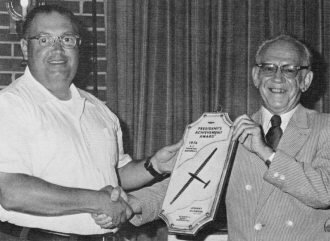
AMA President John Clemens, right, presented his own hand-crafted
President's Achievement Award to Dave Burt during the 1974 RC Soaring Nats in recognition
of Burt's organizational work in establishing the event as truly national. AAM photo
by Bill Coons.
After watching the flying competition for a couple of hours I was so very impressed
by how sparkling fresh and clean everybody looked! Everyone looked like they had
just showered and put on fresh clothes. Was this actually a model airplane flying
meet? Then it suddenly dawned on me why the competition looked so clean. There wasn't
a drop of blood or oily fuel slopped on anyone! It was Radio-Controlled Glider Soaring.
This appearance of personal neatness about everyone was because this was a Sailplane
Soaring meet, where there were no backfiring engines with razor sharp propellers
and no oily fuel required to feed those engines. Of course if you are an RC Soaring
flyer you are accustomed to this "sanitary" condition. but if you haven't before
attended one of these great Soaring Nationals, the cleanliness and the quiet calm
of everything comes as a bit of a pleasant shock.
One hundred and eighty-eight contestants came from twenty-two states to compete
hopefully for the honors of winning in a national championship event and carrying
home some of the prized "hardware." And to coin a phrase, it was a "proud crowd"
because nearly everyone there was wearing his local club insignia. Some wore shirts
or jackets with the club emblem printed on the back or shoulder. or perhaps they
were even embroidered. Some wore sewed-on "patches" or sported decals on equipment
boxes and planes, but all expressed the pride of belonging to their local group
and being identified with the sport of aeromodeling.
The championships were held on the airport grounds of Lewis University, with
the excellent cooperation of the University. Lewis University is located near the
city limits of Lockport, Ill., some 30 miles from Chicago. With the mentioned excellent
cooperation from Lewis University, the meet was practically self-contained. The
school's dormitories took care of the housing problems, and the cafeteria handled
the meals and a handsome banquet. All of these fine accommodations were just a stone's
throw from the flying site, and within easy walking distance.
I discovered that there is another great "plus" in Soaring with RC Sailplanes.
There is no need for acres and acres of hard-to-find and hot-in-the-summertime concrete
takeoff and landing area. Launch area problems in Soaring are as minimal as can
be found in aeromodeling. You simply find the right size area, free of obstructions,
then mow the grass, set up the portable launching winches, and away you go. It will
be cool because grass or bare ground does not reflect the summer heat as does concrete.
Soaring with a winch-and-cable launch is a very non-violent activity, with power
being used for only a few seconds, aimed away from the crowd, applied to only one
model at a time, and all in such an atmosphere of quiet that it will never offend
the neighbors.
How is a flying site like Lewis University Airport discovered? By some wideawake
aero-modeler like Dan Pruss. Who is Dan Pruss? He is a model Soaring enthusiast
who has been one of the real developers of the art right from the start. He found
the Lewis University site because he was hunting for a place to fly his own Sailplanes.
He explained his problem to the authorities, got permission, and found it so ideal
that he wanted to share his discovery with other Sailplaners. When Dan later approached
the University about the possibility of holding a national meet there, the university
reasoned that since they had aeronautical courses in their curriculum it would be
excellent publicity at little investment. The marriage has been a happy one and
should lead to a great future.
Each competition assumes it's own personality, and I enjoy seeking out the things
that make it unique. This meet had cool weather, keen competition, paper sheets
on the dorm beds, and watermelon to eat on the field. Have you ever slept on paper
sheets? Don't snicker! In the interests of economy the dorm beds were furnished
like that. They are fresh and personal and completely satisfactory as long as you
don't toss around and wad them up. To avoid wadding them up I recommend that you
simply fasten the corners down with masking tape. I even made some of my friends
more comfortable with a foot or so of masking tape. I hope to have the masking tape
concession at the next meet!
A welcome visitor to the meet was a Chicago hobby distributor, John Osborn of
Midwest Model Supply, who appeared with a trailer loaded with cold watermelons.
John cut the melons with a sharp machete and fed everybody in the place. It was
a much appreciated gesture and added another bit of the unique to the Soaring Nats.
The competition itself was run so smoothly and so well that it could easily have
been just taken for granted. All of the fun of flying was topped off with an excellent
banquet put together by John Nielsen. Here the awards were given out, along with
a zillion door prizes. At the banquet I had the privilege of giving my President's
Achievement Award to hard working Dave Burt for the great amount of organizational
work he has put in over the several years of getting the Soaring Championships to
really soaring.
A symposium was held on the day after the meet, July 25th, where the final decisions
were made to organize Radio Control Soaring under one national banner. The National
Soaring Society was formed, with a hard working organizer, George Durney, as president.
The avowed purpose of the new 1,000-member organization is the administrating and
furthering of the sport of Radio Controlled Soaring, directed democratically by
a president and a fifteen-member Board of Directors, offering representation in
all of the eleven districts of our national governing body, the Academy of Model
Aeronautics.
With a personal salute to "whisper flying," I offer congratulations and best
wishes from all of the Academy of Model Aeronautics membership to a proud new special
interest organization, the National Soaring Society, and to the leaders who put
the whole cloth together from so many fine threads!
John E. Clemens AMA President
Posted November 6, 2021
|